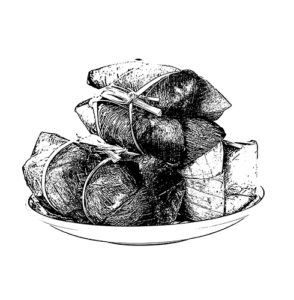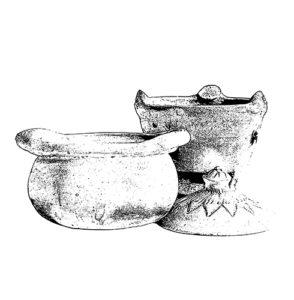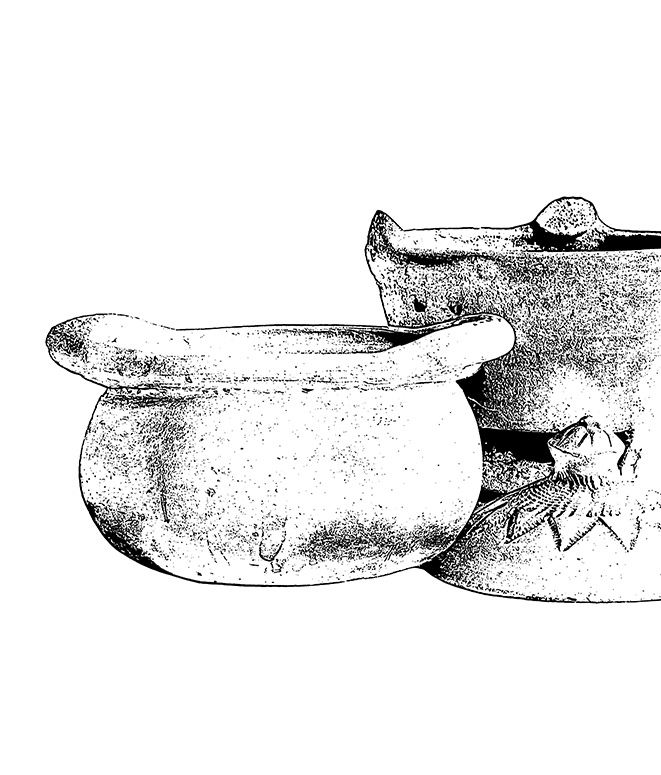Sealed-cooking traditions date back centuries and range widely in style, but then as now, chefs want the same thing: proteins and vegetables as tender as they are flavorful.

WRAPPING IN LEAVES
HISTORY:
First mankind learned to cook with fire, then it learned to be neat about it. This ancient method protected fragile foods like fish from sticking to hot stones or charring on open flames—and it still works for today’s grill grates. Wrapping in leaves comes with all the sealed-cooking superlatives and lends a subtle nuttiness (banana leaves) or sweetness (fig leaves) to your food. Others (grape leaves) make a tasty edible parcel.
DISH:
Joong (China)—Glutinous rice mixed with Chinese sausage, salted duck egg yolks, and pork belly steamed in bamboo leaf packages. A sous vide version of this dish, called zongzi in Mandarin and joong in Cantonese, will intensify the aromatic flavor of the leaves.
SEALING INSIDE ORGANS
HISTORY:
Finding a pig’s bladder today might be harder than finding a truffle growing in Arizona, but cooking food in bladders, stomachs, and intestines has been common for centuries. From kirshe in Palestine to nyanya in Russia, such dishes used more of the animal when meat was harder to find or preserve. Cultural significance or novelty have kept some of them on modern menus, as with haggis in Scotland or poularde en vessie in French.
DISH:
Poularde en Vessie (France)—A bresse chicken with truffle-stuffed skin cooked inside a pig’s bladder.

BURYING UNDERGROUND
HISTORY:
It varies by region, but buried ovens usually start with a pit layered with hot stones, then leaves or seaweed, then food stuffs placed in according to cook time. Burlap, wet cloth, or leaves seal the oven. Inside, the food steeps in its own flavors and a delicious smokiness from these layers. Pachamanca, as it’s called in Peru, dates back to the Incan Empire. In New Zealand, sweet potatoes cook in a Māori oven called a hāngī, and in Hawaii, whole pigs go into the imu with banana stumps.
DISH:
Cochinita Pibil (Mexico)—Pork seasoned with achiote seeds and garlic, wrapped in banana leaves, and cooked in a pit. Doneness is hard to gauge with an earth oven, so start the ingredients sous vide and finish them in the pit to get the signature smokiness.
PACKING IN SALT
HISTORY:
Although it appears in culinary histories from Sicily to China, salt-packing has been skewered by some modern chefs as a pure presentation move. Before you get salty about it, know that salt-packing does accomplish something on a molecular level. Sodium ions are both heat absorbing and conductive—trapping heat and transferring it along the surface of your chicken, fish, or beef to cook it evenly.
DISH:
Whole Fish (Sicily)—In Sicily, whole sea bass as well as salmon are cooked in a salt crust. Cracking open a salt crust and digging into a whole fish tableside is aesthetically pleasing, hedonistically indulgent, and augments certain sous vide dishes.

COOKING IN CLAY
HISTORY:
Cooks from Morocco to Colombia hit pay dirt when they started cooking in clay vessels. Earthenware predates cast iron cookware, and many cultures still use it to develop deep flavors in hearty stews, sweet rice dishes, and a bevy of meats. Sealed clay vessels—from China’s saw kuo to India’s heavy-bottomed handi—are porous, which encourages heat to circulate inside and cook food evenly.
DISH:
Sakkarai Pongal (India)—A rice pudding dessert with cashews and raisins served for the south Indian harvest festival of Pongal. Sous viding such dishes and reheating them in clay perfectly cooks the food while endowing it with mineral-rich flavors.
POTTING IN FAT
HISTORY:
Had plastic wrap existed in medieval times, then duck confit as we know it might not. European countries preserved meat in pots topped with a layer of animal fat—lighting the way for a slew of British meat pastes, rillettes, and today’s confit (from the French for “to preserve.”) Confit meat is slow-cooked in fat at a temperature just high enough to tenderize the meat’s connective tissues without dehydrating it.
DISH:
Duck Confit (France)—Salt-cured duck legs and thighs oven-poached in melted duck fat. A sous vide confit stays at the proper temperature without constant monitoring. Finishing it in a hot skillet easily achieves a Maillard effect.
Buy the Magazine
Buy NowDedicated to the Art & Science of Sous-Vide
The first publication devoted to the art and science of sous vide cooking, featuring innovative recipes, visual inspiration, expert techniques for cooking sous vide at home, and exclusive interviews with world-class chefs.

